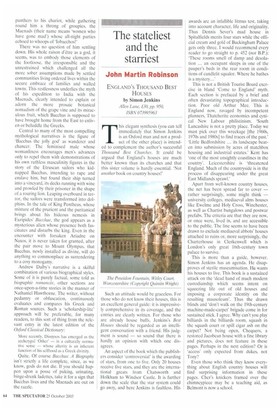The stateliest and the starriest
John Martin Robinson
ENGLAND'S THOUSAND BEST HOUSES by Simon Jenkins Allen Lane, £30, pp. 950, ISBN 073995963
This elegant synthesis (you can tell immediately that Simon Jenkins is an Oxford man and not a product of the other place) is intended to complement the author's successful Thousand Best Churches. It could be argued that England's houses are much better known than its churches and that this sister volume is hardly essential. 'Not another book on country houses!'
Such an attitude would be graceless. For those who do not know their houses, this is an excellent general guide: it is impressively comprehensive in its coverage, and the entries are clearly written. For those who are already house buffs, Jenkins's Best Houses should be regarded as an intelligent conversation with a friend. His judgment is sound — so sound that there is hardly an opinion with which one disagrees.
An aspect of the book which the publishers consider 'controversial' is the awarding of stars, from one to five. Only 20 houses receive five stars, and they are the international greats from Chatsworth and Holkham to Windsor Castle. It is further down the scale that the star system could go awry, and here Jenkins is faultless. His awards are an infallible litmus test, taking into account character, life and originality. Thus Dennis Sever's mad house in Spitalfields merits four stars while the official cream and gold of Buckingham Palace gets only three. I would recommend every reader to go straight to p. 452 (not B.P.): 'These rooms smell of damp and desolation ... an occupant sleeps in one of the pauper's beds in the rear room in conditions of candlelit squalor. Where he bathes is a mystery...'
This is not a British Tourist Board exercise in bland 'Come to England' myth. Each section is prefaced by a brief and often devastating topographical introduction. Poor old Arthur Mee. This is England now, ravaged by incompetent planners, Thatche rite economics and cynical New Labour philistinism. 'South Lancashire is not a pretty place. Today we must pick over this wreckage [the 1960s, 1970s and 1980s1 to find traces of the past.' 'Little Bedfordshire ... its landscape beaten into submission by acres of matchbox housing and industrial estates.' Kent has 'one of the most unsightly coastlines in the country'. Leicestershire is 'threatened England. Much of the countryside is in the process of disappearing under the great East Midlands sprawl.'
Apart from well-known country houses, the net has been spread far to cover — rather surprisingly, some might think — university colleges, mediaeval alms houses like Ewelme and Holy Cross, Winchester, as well as Chartist bungalows and postwar prefabs. The criteria are that they are now, or once were, lived in, and are accessible to the public. The line seems to have been drawn to exclude mediaeval abbots' houses attached to ruins or, more surprisingly, the Charterhouse in Clerkenwell which is London's only great 16th-century town palace to survive.
This is more than a guide, however. Simon Jenkins has an agenda. He disapproves of sterile museumisation. H wants his houses to live. This book is a sustained attack on the 'dead hand of much modern custodianship which seems intent on squeezing life out of old houses and imposing a corporate identity on the resulting mausoleum'. Thus the drawn blinds and 'don't walk on the 19th-century machine-made-carpet' brigade come in for sustained stick. I agree. Why can't you play billiards in the billiards room, squash in the squash court or spill cigar ash on the carpet? Not being open, Chequers, a restored Jacobean house with a fine library and pictures, does not feature in these pages. Perhaps in the next edition? Or is 'access' only expected from dukes, not Tony?
Even those who think they know everything about English country houses will find surprising information in these pages. Cher's knickers framed over the chimneypiece may be a teaching aid, as Belmont is now a school.


































































































 Previous page
Previous page